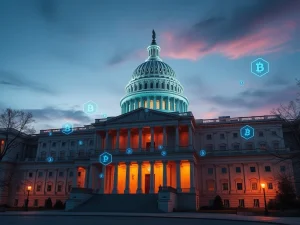Unlocking Crypto: Pakistan’s Bold Regulatory Move, Bitcoin’s Impending Institutional Surge, and the Stablecoin Future

Stay ahead in the fast-paced world of digital assets. Today’s **crypto news** brings significant developments from global regulation to market predictions. Pakistan is making headlines by inviting major international virtual asset service providers (VASPs) to apply for operating licenses. This move signals a progressive shift in its approach to digital assets. Meanwhile, a prominent Wall Street veteran forecasts a substantial increase in institutional **Bitcoin allocation** by year-end. Furthermore, a leading crypto executive predicts a fascinating **stablecoin future**, suggesting these assets will soon lose their individual tickers. These key events shape the ongoing narrative of the cryptocurrency market, influencing everything from Bitcoin’s price to the evolution of decentralized finance (DeFi) and Web3 technologies.
Pakistan Crypto: A New Era for Digital Assets
In a significant development, Pakistan has extended an invitation to global crypto firms, encouraging them to seek operating licenses under its new federal regulatory framework. This initiative marks a pivotal moment for **Pakistan crypto** adoption and its integration into the global digital economy. The Pakistan Virtual Asset Regulatory Authority (PVARA) formally requested Expressions of Interest (EoIs) from leading virtual asset service providers (VASPs) this past Saturday. The goal is to establish a transparent and inclusive digital financial ecosystem within the nation.
Bilal bin Saqib, PVARA chair and minister of state for crypto and blockchain, emphasized the strategic importance of this invitation. He stated, “This EoI is our invitation to the world’s leading VASPs to partner in building a transparent and inclusive digital financial future for Pakistan.” This statement highlights the country’s commitment to fostering a regulated yet innovative environment for digital assets. Furthermore, eligibility for these licenses is strictly limited to firms already regulated by recognized international authorities. These include the US Securities and Exchange Commission (SEC), the UK Financial Conduct Authority, the EU’s VASP framework, the UAE’s Virtual Assets Regulatory Authority, and the Monetary Authority of Singapore. This selective approach ensures that only reputable and compliant entities enter the Pakistani market, enhancing trust and stability. Pakistan currently ranks third globally in crypto adoption, indicating a strong existing demand for digital asset services. This regulatory opening could significantly bolster its position.
Bitcoin Allocation: Wall Street’s Bullish Outlook
Traditional finance (TradFi) institutions are poised to significantly increase their **Bitcoin allocation** before the end of the year. This is the forecast from Wall Street veteran and macro analyst Jordi Visser. During a recent interview with Anthony Pompliano, Visser confidently stated, “Between now and the end of the year, the allocations for Bitcoin for the next year from the traditional finance world are going to be increased.” This prediction underscores a growing institutional acceptance of Bitcoin as a legitimate asset class. He further emphasized that Bitcoin’s allocation number will climb across various investment portfolios. This anticipated surge in institutional interest could provide substantial upward pressure on Bitcoin’s price. Many market participants are currently debating whether Bitcoin will reach its cycle peak in the final quarter of this year. Visser’s outlook suggests that institutions are preparing for long-term strategic positioning, rather than short-term speculation. Their increased allocations in Q4 are likely in preparation for the upcoming year. This indicates a deepening integration of digital assets into mainstream financial strategies.
The Stablecoin Future: A Shift Towards Commoditization
The landscape of stablecoins is set for a significant transformation, according to Mert Mumtaz, CEO of Helius, a remote procedure call (RPC) node provider. Mumtaz predicts that US dollar-pegged stablecoins will eventually lose their individual price tickers. Instead, they will simply be represented as “USD.” This fascinating **stablecoin future** reflects the increasing commoditization of these digital assets. From a user’s perspective, Mumtaz argues, there is little functional difference between various dollar-pegged stablecoins like USDC, USDT, or USDX. Therefore, exchanges and applications will likely streamline the user experience. They will achieve this by swapping stablecoins through backend infrastructure that remains invisible to the end-user. He elaborated, “The eventual endgame is that you don’t see the ticker at all. The apps will just display ‘USD’ instead of USDC, USDT, or USDX, and they will swap everything in the backend via a standardized interface.” This development signifies a maturing market where the underlying technology becomes seamless. The focus shifts entirely to the utility of the dollar peg. The stablecoin market cap has already surpassed $280 billion, highlighting its crucial role in the broader crypto ecosystem. This move towards generic representation could further solidify stablecoins as fundamental infrastructure rather than distinct branded assets.
Global Crypto Regulation and Its Impact
The broader theme of **crypto regulation** continues to evolve globally, impacting every facet of the digital asset market. Pakistan’s move to license international firms exemplifies a growing trend among nations. Many governments are seeking to formalize and control the crypto space. This approach aims to prevent illicit activities, protect investors, and harness the economic potential of blockchain technology. Regulators worldwide are grappling with the complexities of digital assets, from DeFi to NFTs and Web3. The Financial Action Task Force (FATF) guidelines, for instance, heavily influence how countries like Pakistan approach virtual asset service providers. Strict adherence to these guidelines is often a prerequisite for global financial integration. This regulatory push provides a clearer operating environment for businesses. It also offers a degree of legitimacy that can attract more traditional investors. The ongoing debate around clear regulatory frameworks remains central to crypto’s mainstream adoption. This affects how institutions view Bitcoin and how stablecoins are integrated into financial systems. Clear rules build trust and foster sustainable growth within the crypto industry.
Navigating Today’s Crypto News Landscape
Today’s **crypto news** highlights critical trends shaping the digital asset world. From Pakistan’s welcoming stance towards global crypto firms to Wall Street’s increasing appetite for Bitcoin, the institutional narrative is strengthening. Moreover, the predicted evolution of stablecoins towards a ticker-less, commoditized future indicates a maturing market focused on seamless utility. These developments collectively point to a future where digital assets are more integrated into both national economies and global financial systems. Investors and enthusiasts must remain vigilant, understanding how these shifts impact their portfolios and the broader market. The intersection of regulation, institutional adoption, and technological evolution defines the current era of cryptocurrency. These factors will continue to drive innovation and market dynamics for years to come. Staying informed about these crucial trends is essential for anyone involved in the digital asset space.









